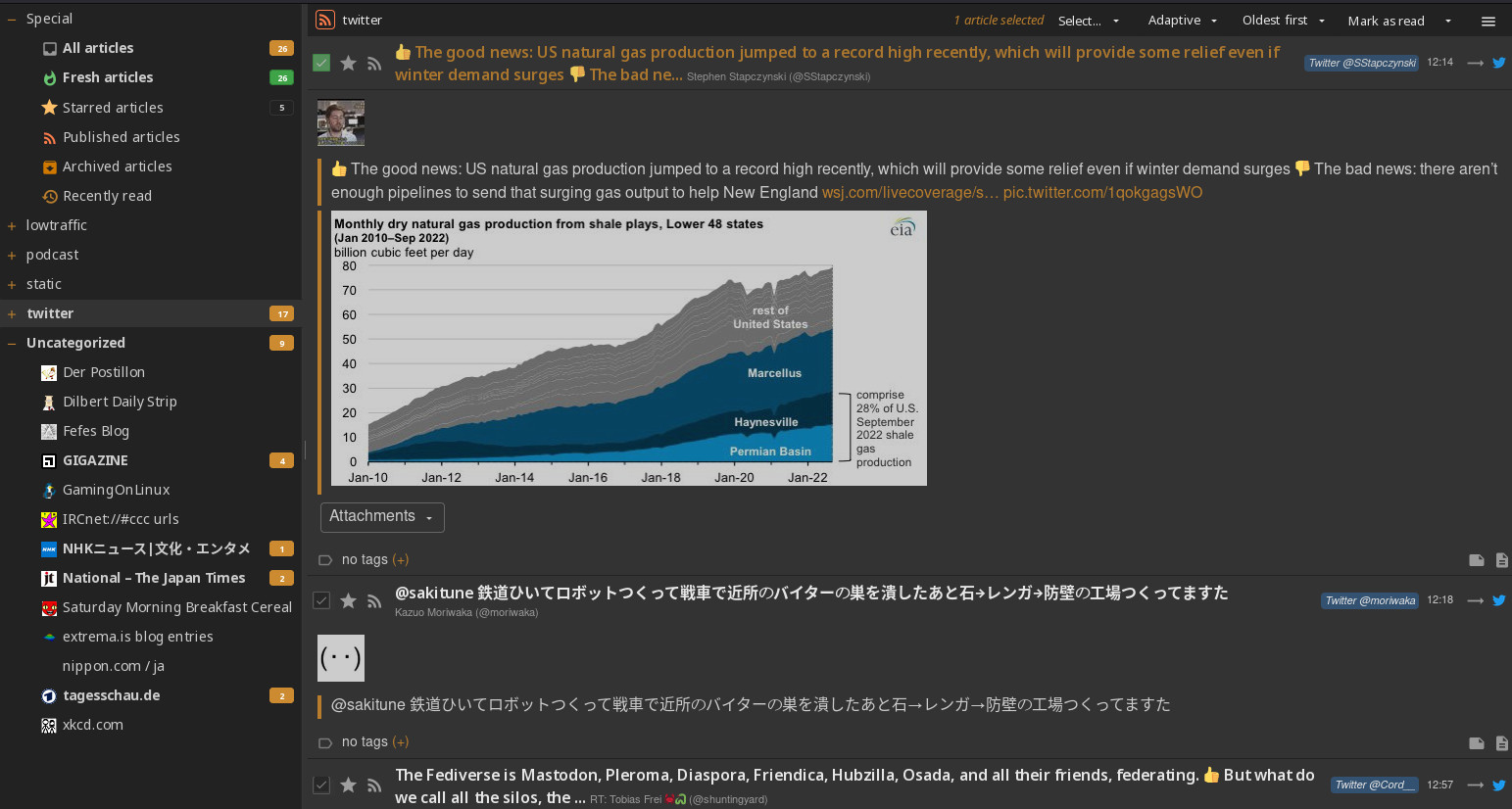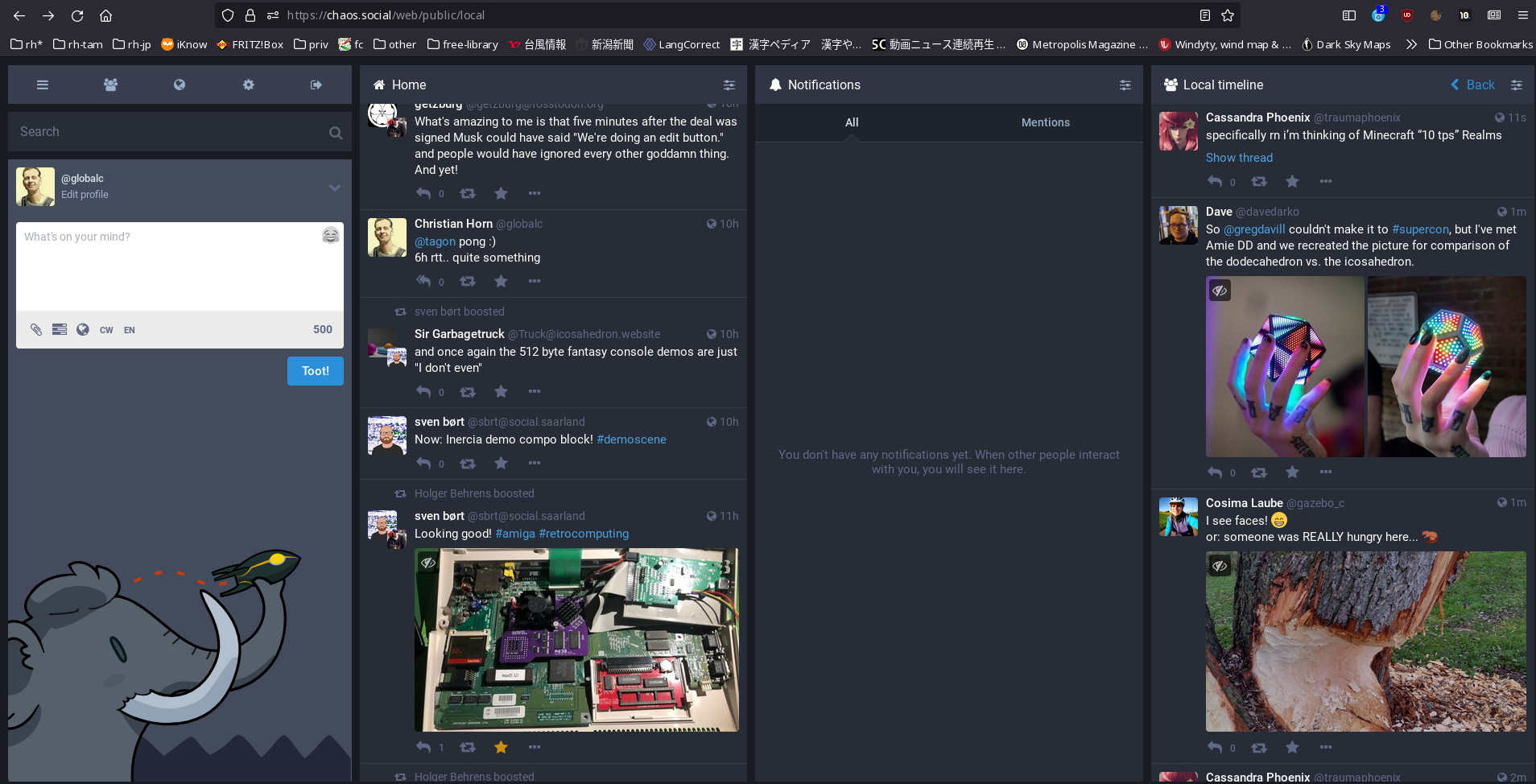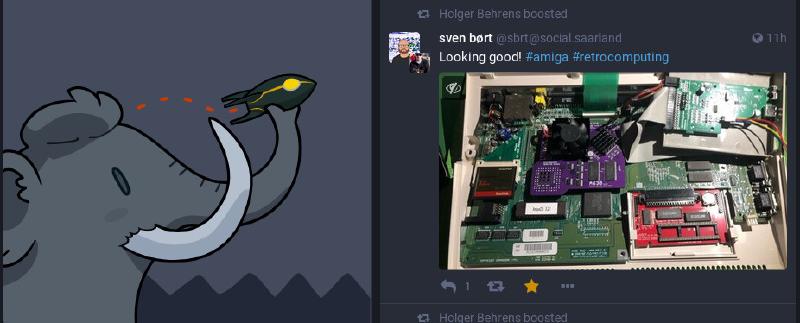What’s this about?
This is my attempt of an overview of my current social networks/news fetching setup.
Ever explained a colleague or friend a technical problem, and along with giving the explanations understood the issue better, leading to a solution? Summarizing my current social network/news fetching setup forces me to rethink it, and can give ideas what to improve.
Also, the increasing numbers of Mastodon users show that also many people rethink their habits and tools, so this can also provide food for thought for others.
RSS feeds are the base
Initially I had websites interesting for me open in browser tabs, and would frequently reload these, and then if these were complex pages also have to scroll down and try to understand if something changed. That improved very much with RSS feeds: these are files provided by for example a website, representing the website in a machine readable way. When websites offer RSS feeds, I can frequently fetch their feed, and easily decide if something changed.
I run Tiny Tiny RSS (ttrss) for that, an open source software which frequently fetches feeds and notifies me about changes. Many pages offer feeds, I also offer them for my wiki and other sites. My main interface to ttrss is my webbrowser, my first tab in Firefox accesses the ttrss instance I am running. I also access ttrss from Android mobile, for example when I’m on the train: apps are then accessing the ttrss instance, showing the feeds, and one can click the link to read the full news article on the website.
For example I read a feed with news from tagesschau.de, and see headlines of various news presented in my ttrss interface. With key combinations I can jump to the next news entry, and if something sounds interesting I can open that news on tagesschau.de directly in a new browser tab.
Everything is a feed!
Websites themself are in the best position to offer feeds of their contents, but many opt into not doing that, maybe they want to force people to watch their site directly so they can distribute more ads, or can collect more data. One of the best projects around this is rss-bridge. One can install that code on an own webserver, and then access URLs provided by rss-bridge as feeds. rss-bridge under the hood is then contacting the webserver, extracting data from there and offering it as feed. So with this, for example the dilbert webcomics become available as feed, and I can read them via ttrss.
I do not consume all articles directly: in the morning I skim over new items presented by ttrss, open some in the browser and have a look. Many of these articles are then interesting, but so long that they need more time to read than I can invest right now - for these items, ttrss allows to mark the article with an asterisk. These items are then marked as ‘read’ in ttrss, but appear in a section called ‘starred articles’ where I consume them later.
Yes, really everything can become a feed! I’m still around on the chat network IrcNET, which uses the IRC protocol. An RSS feed is just a text file with some XML, so a small script I created is just frequently opening the logfile from these IRC channels, taking out posts which look like a URL, and then these are ending up in my ttrss instance.

Mastodon as social network
Besides the browser tab with ttrss, I have a tab with Mastodon open.
Google plus closed down, I left Facebook years ago, but Mastodon
has stuck. Many of my interests are around open source, technology
and language learning - we have nice communities around these on
Mastodon.
I also occasionally post on Twitter, and like to follow some people who are not on Mastodon: also for these, rss-bridge can easily make the Twitter posts of users available as feeds, and my ttrss offers these in the most convenient way. Things I learned from that: when I was watching my twitter timeline, I missed updates from people I ‘follow’ via the Twitter-follow-function. Now, I catch all posts from these users.
For me, having Mastodon separated ‘feels right’, but in case you want to see posts of Twitter users in your Mastodon timeline, this would work:
- rss-bridge to get the tweets as feeds
- Then using this or other software to get the feeds into Mastodon.

What about Podcasts?
So for podcasts, I use no dedicated fetcher/app. I use ttrss to fetch the feeds for podcasts, get notified there. For example, when a new episode of the Bilingual news podcast (weekly talk about news, in Japanese and English), I mark the ttrss item with the ‘star’, and in a terminal I run script ’latest_selfhosted.sh’ which fetches the last episode, drops it in a directory for podcasts. After a few days soem podcasts gathered there, then I connect my mp3player via USB and move the files to the player. The player runs ‘rockbox’ and can also set bookmarks. When I finish a podcast file, I remove the file, and later in the ttrss interface I remove the ‘star’ for that entry - in many cases I also open links belonging to that podcasts feed item, like links related to the podcasts content.
Things I love about the setup
For me, the current state works very well. The feeds are openly standardized as rss/atom, and Tiny Tiny RSS as well as the browser and Android app I use for access are open source, with all it’s benefits. For communication, with Mastodon I’m now happy that there is no longer a single company able to enforce their own rules.
I feel like Mastodon could really help to also make new connections: when we entered Corona, many from the Tokyo Linux user group (also other groups had the idea) tried to volunteer, to work with schools to have them try out open source software to lift lessons to the internet. The issue turned out to get connections to teachers and schools. In the end, I had 2 sessions with a school which turned out great (and did lead to this documentation), but really this should be done on bigger scale. In Mastodon I see instances appearing with focus on teaching, and it seems like getting such contacts might be easier. I also got into touch with old friends, after years.
Things I would like to improve
Just some recent thoughts on what could be improved:
- Mastodon timeline, quite much content.
For ttrss, I can nicely pull new items as I have time. For Mastodon, I have a long newsfeed, and the more people I follow, the more new items get available. Consuming the timeline is harder.. but I also would not want that as feed in ttrss, that would somehow not fit for me. - Separation by topics is an issue. I have currently a single
Mastodon account, and my posts cover the wide range of
open source, Japan, language learning and more. People might
be interested in just one of these, but they get all.
In reverse, I also decide to follow (or not) others from the signal/noise ratio of what seems interesting. - In the morning, when opening the browser tab with the Mastodon timeline, the timeline is scrolled up showing the most recent entry. Would be convenient to have it scrolled down to the last entry I did already see, so then I can directly read up the new entries.
- Attribution. So for Mastodon, all people I follow see that, but with rss-bridge I actually create feeds from the twitter users tweets-page, that is independent of me ‘following’ them on twitter. If many people do this, it might result in actually very interesting content from twitter users not being reflected in their follower-number. Not feeling sorry there for the twitter algorythms, but the user themself..
- The unsolved problem of money making: some podcasts I listen to start to ask for money based on proof-of-work blockchains, which I can not agree to - that’s just further accelerating the climate crisis. But having a good other mechanism to help content creators for podcasts etc. would be nice.
